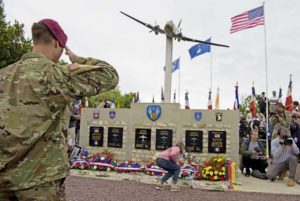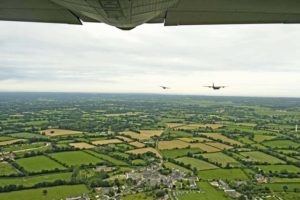
by Airman 1st Class Kristof Rixmann
86th Airlift Wing Public Affairs
PICAUVILLE, FRANCE — Ten United States Air Forces in Europe-Air Forces Africa service members paid respects as they attended a ceremony held to commemorate all service members that served on D-Day, June 6, 1944, at the U.S. Air Force monument in Picauville, France, June 4.
U.S. Air Force Maj. Gen. John B. Williams, HQ USAFE-AFAFRICA mobilization assistant to the commander, provided key remarks and personal thoughts as the ceremony’s guest speaker.
“It’s been a lifetime ambition of mine to see the D-Day commemorations here,” said Williams. “This is the first year I’m attending Normandy for D-Day’s anniversary and this year is such a special year as it’s the 75th anniversary. With D-Day, seeing the terrain where so many U.S. sacrifices were made is a poignant reminder of the cost of our freedom.”
Williams went on to speak about the importance of families in Normandy as D-Day is remembered today.
“I’ve had the opportunity to experience the hospitality and gratitude of the people of Normandy as we think back to D-Day,” said Williams. “When you talk with people here you can see D-Day is a part of their family memories and these memories are very real for them, as if it happened yesterday. I spoke with some people that recalled the events as they were children at the time and, with tears in their eyes, they said ‘thank you.’”
Williams said it’s very gratifying to know the events that transpired 75 years ago will be remembered well into the future in large part due to the efforts made by the French to ensure the memories of D-Day remain eternal.
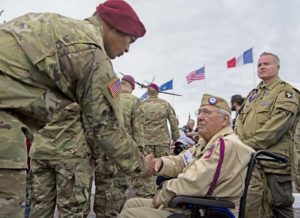
U.S. Air Force Col. Joseph Wenckus, 86th Airlift Wing vice commander, who attended the ceremony with Mr. Scott Lockard, 86th Airlift Wing vice director, and other service members from USAFE-AFAFRICA, also shared thoughts on the D-Day invasion and the commemorations that followed 75 years later.
Wenckus, who has visited Normandy several times and has studied the D-Day battle for years, believes the peace experienced today should not only be valued but protected.
“One of the speakers today spoke about the fragility of peace and how desperately U.S. forces fought to gain peace on the European continent. That’s something we can’t take for granted. At Ramstein Air Base, in particular, we need to treasure the peace we are enjoying, and making sure we are ready to defend ourselves at a moments’ notice is a key part in what we do on a day-to-day basis.”
Today, Picauville, firmly stands as a symbol of peace, no matter how fragile peace may be, due to the deep ties the village has to “The Longest Day,” June 6, 1944.
In the preparation phase of Operation Overlord, otherwise known as D-Day, the small village was intended to be one of the first towns liberated by the Allied forces.
The 508th Parachute Infantry Regiment, today known as the 82nd Airborne Division, was charged with seizing Picauville with the intention of using the land as an aviation runway for P-47 Thunderbolts belonging to the 405th Fighter Group.
On the fateful day of June 6, 1944, C-47s carrying the 508th PIR were on target for the drop zone of Picauville. However, due to heavy anti-aircraft fire the pilots flew above the cloud layer, consequently reducing their own visibility.
Despite being on target for Picauville, the 508th PIR dropped from the C-47s at an altitude far too high at approximately 700 meters; a standard drop height being 150 meters.
Due to the heavy anti-aircraft defenses, the difficulties encountered by the pilots caused half of the regiments’ paratroopers to land more than 15 kilometers from the drop zone, thus unable to accomplish their objective of seizing the village the same night.
Approximately three hours after the landing, good fortune swung in the favor of Allied forces when 12 paratroopers from the 508th PIR, who sought information from civilians living in the area, waved over an approaching vehicle for questioning. The U.S. paratroopers opened fire on the vehicle after the driver refused to stop. In the wreckage, the paratroopers pulled out a deceased German General, Wilhelm Falley, commander of the German infantry division controlling Picauville.
This loss proved to be a crippling blow to the axis defense controlling the village, however, it was not enough to overtake the area until four days later when an Allied offensive finally managed to seize the village.
Under Allied control, the aviation runway was built as planned for the P-47 Thunderbolts during their night missions.
The history of the village during WWII makes Picauville a more than deserving candidate and location for D-Day commemorations, such as the one seen on June 4 during the 75th anniversary of D-Day.
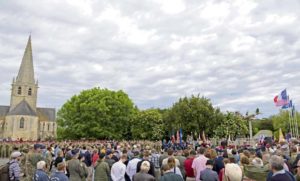
French national, Denis Dennebouy, President of the Association of Picauville, said he is grateful for the persistent presence of U.S. forces during D-Day commemorations.
At the ceremony, Dennebouy, in suit and tie, wore several pins. Individually they showed support to one entity but together, seen on one suit, created a sum greater than its parts. Dennebouy wore a U.S. Air Force pin, one for the U.S. Army, a U.S.-French flag and a German-French flag pin. Together, they illustrated not only Dennebouy’s sense of patriotism for his country but his gratitude for U.S. forces and even forgiveness for the enemies of yesterday.
Dennebouy, who spoke during the ceremony, offered a lasting message for all generations as D-Day is remembered 75 years later.
“We will never forget,” said Dennebouy. “Freedom and peace are very costly. The blood shed for Normandy and Europe gave us the freedom and peace we have today. We will never forget the 101st Airborne Division, the 82nd Airborne Division and the 435th Troop Carrier Group. I want people to remember their sacrifice because without them we would not have our freedom and peace today.”
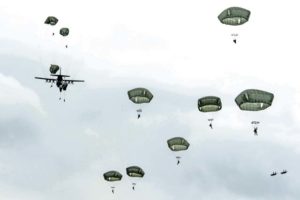
Towards the ceremony’s conclusion, U.S. Army Airborne infantrymen expressed their gratitude to the U.S. D-Day liberators who attended the ceremony. Some then proceeded to swap patches with German Airborne infantrymen as mementos to mark the commemorations. These acts evidenced two ideas: the cost of freedom will never be forgotten and the enemy of yesterday is the friend of today.

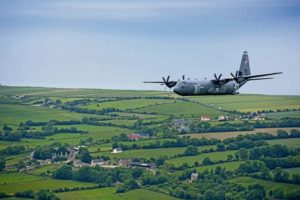
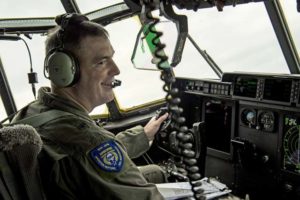
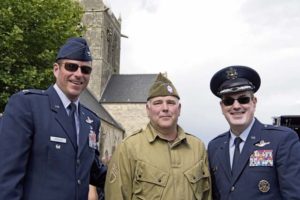
.

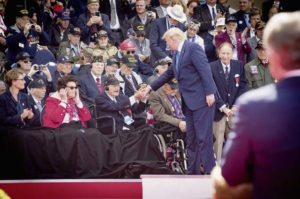
.
